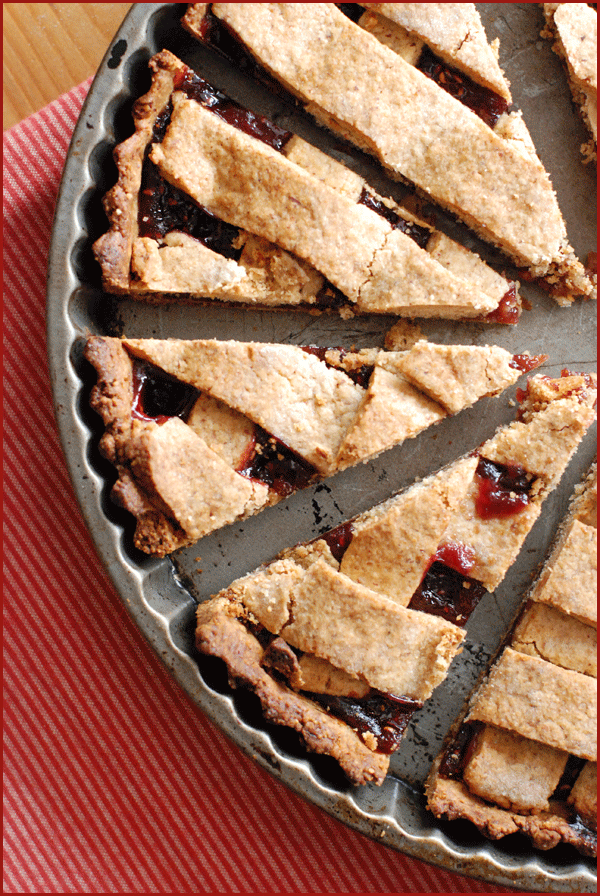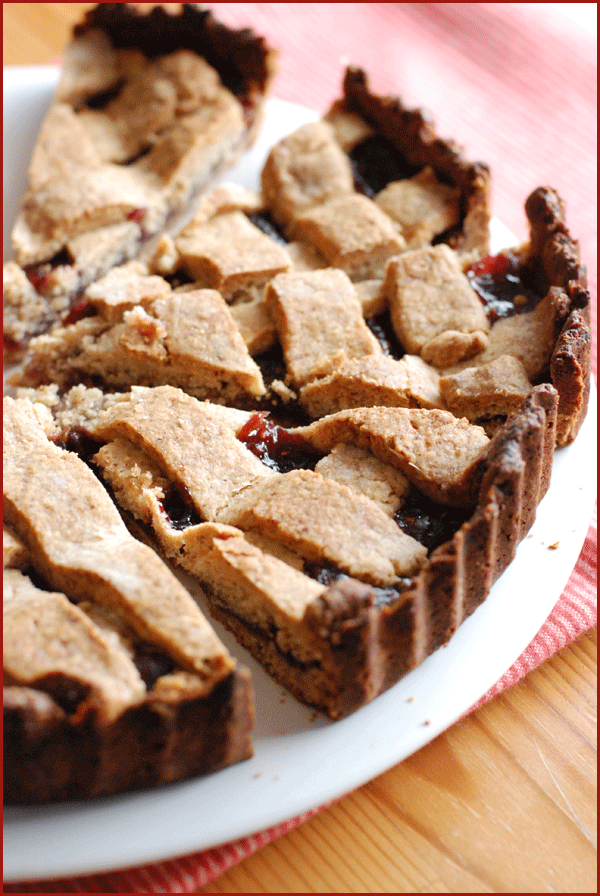 If you've eaten your vegetables -- in this salad and this delightfully spring-y side dish and oh, this is quite nice, too, I forgot about it! -- I've got some dessert for you. It's Linzer Torte, and it's such a steadfast ritual in this house, I'm practically embarrassed to have not shared it before now.
If you've eaten your vegetables -- in this salad and this delightfully spring-y side dish and oh, this is quite nice, too, I forgot about it! -- I've got some dessert for you. It's Linzer Torte, and it's such a steadfast ritual in this house, I'm practically embarrassed to have not shared it before now.
In a world where desserts are froufrou and frosted and altogether cupcaketastic, Linzer is a refreshing aberration. It's dark, dense, and jammy, with not a dab of frosting in sight. Granted, it's a bit on the fussy side. But between you and me, if you want to skip the whole lattice crust situation and just plop clumps of the dough on top of the jam, it'll taste just as good. The almond flour dough is spiked with cinnamon, cloves, and lemon zest. There are egg yolks. There is raspberry jam. I'm pretty sure I've done my job -- you want some, right?
No problem. We'll get right to it. First things first: go forth and get ye some very good raspberry jam. You're meant to use black raspberry, but red works just fine (it's what I usually use). None of the crappy junk -- there's a whole layer of this cake that's nothing but jam, so you may as well invest in the good stuff. I like St. Dalfour brand; if you live in DC, the raspberry preserves from Star Hollow Farm are wonderful. You can get them at the AdMo market. Of course, you could always make them yourself.
Next, get some almonds. Here's a secret: While the recipe has you toast and then blend almonds into a fine powder, you can also buy almond flour, and toast it. I've provided instructions below, just in case you want to be fabulously lazy.
Fear not, there's plenty of fuss to make later on. If you opt to go all the way with the lattice crust, there are a couple ways to shortcut. Naturally, I've listed all the tricks I know. Just do me a favor: don't let the project-y nature of the torte get in the way of making it. Few things are worth the trouble like Linzer Torte.
Linzer Torte adapted from The New Best Recipe
1 1/2 cups sliced almonds with skins (6 oz) or equal weight almond flour 1 1/2 cups all-purpose flour 2 teaspoon finely grated fresh lemon zest 1/4 teaspoon salt 1/2 teaspoon cinnamon 1/8 teaspoon ground cloves 1/2 cup sugar 10 tablespoons unsalted butter, softened 2 egg yolks (1 egg will work in a pinch, I've tried it) 1 teaspoon vanilla 1 cup red-raspberry jam
Preheat oven to 350. If using whole almonds, spread on baking sheet in a single layer and toast about 8 minutes, until golden brown. If using almond flour, spread on baking sheet just the same, but toast about 5 minutes, checking frequently, until golden. Process whole almonds until very fine. Mix with flour, cinnamon, cloves, salt, and lemon zest in a medium bowl.
In the bowl of a stand mixer fitted with the paddle attachment, beat butter and sugar on medium-high until light, fluffy, and well-combined. Scrape down the sides of the bowl. Add egg yolks and vanilla and mix on medium until combined; batter will look somewhat clumpy, and that's okay. Add flour mixture and mix on low just until combined. Form dough into a ball, wrap in plastic, and chill at least 30 minutes.
Turn oven up to 400. Divide dough in half. Shape one half into a flat disk and return to the fridge; take the other half and press into a 9-inch tart pan with false bottom. You can try using a flat measuring cup or ramekin to even out the dough layer, but I find the dough too sticky for this to work, so I use my palm, and it works just fine. Be sure to press it up the sides as well. Chill 15 minutes.
Prick dough a couple times with a fork, line it with foil, fill with pie weights or beans or rice, and bake 20 minutes. Remove weights, and bake until barely golden, about 5 minutes longer. Lower heat to 350.
Spread the raspberry jam over the partially-cooled bottom crust in an even layer, all the way to the edges.
Here's the fussy part: take the remaining dough out of the fridge, and roll to 1/8-inch thick between two layers of lightly floured parchment or wax paper. Peel off the top layer of paper, and use a very sharp knife or blade to slice dough and parchment together into about 10 even strips, trimming and reserving scraps. Be sure to slice all the way through to the parchment, so that your strips are easily handled.
At this point, you're going to lay strips of dough into a lattice (or lattice-like) crust). To lay a strip down, pick it up at either end by the parchment, hold it parchment-side down over the spot you want it to go, and flip it over. The strip will start to peel away from the parchment. Set the strip correctly in place, and peel back the parchment.
There are two options for how to do this:
1. Lay down two strips, in the same direction, one about 75% of the way to the left side of the tart and one 75% of the way to the right side. Turn the tart 90 degrees. Repeat: lay down two strips, in different spots, perpendicular to the first two you laid down. Turn tart again, and continue laying strips and turning tart until all strips have been used. This will give the illusion of a lattice, without all the fuss.
2. Say to hell with the lattice: lay half the strips in one direction, rotate the tart, and lay the other half down in the perpendicular to the first half.
The tart will look beautiful either way; but do us all a favor, and don't try to actually weave these strips, because it won't work.
When your top is arranged as you want it, bake about 1 hour. When jam is bubbling and top crust is browned, remove from the oven and set on a rack to cool, which will take 2-3 hours. Serve at room temperature. You might dust the top with powdered sugar before serving. Store in the fridge; tart is actually quite delicious after a night in the cold.
